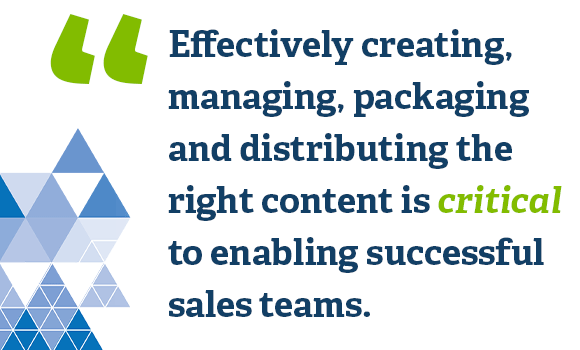“Sales asset management” (SAM) is a misunderstood term in the world of B2B sales and marketing. No, it is not a new name for a group of financial services relationship managers—it actually has nothing to do with the financial services industry. Some may also argue that it is more of a marketing function than sales, despite the fact that one third of its namesake is “sales.”
While SAM can be difficult to wrap your head around, it is incredibly important for B2B organizations that are trying to better align their sales and marketing teams, increase sales efficiency, and improve marketing effectiveness.
Sales asset management helps B2B organizations manage their sales assets (i.e. internal reference materials, customer-facing collateral, presentation decks, etc.) in a single, easily-accessible portal. B2B organizations use SAM solutions to create, store, manage, deliver, and analyze the usage of content from a single view. SAM is sometimes confused with sales enablement, because the two are very closely related.
To put it simply, a sales enablement strategy includes sales asset management. SAM is one of many functions of a sales enablement strategy that helps to get the right information, content and support to sales organizations as efficiently and seamlessly as possible. Certain SAM solutions can function as part of the right sales enablement strategy.
Why does Sales Asset Management matter?
While the importance of a sales enablement strategy is undeniable, it wouldn’t have legs if it weren’t for sales asset management. If your sales organization is experiencing any of the pain points below, it may be worth looking into a SAM investment:
- Content is stored in disjointed repositories: It’s likely that sales, marketing, product, and development teams all have their respective content stored in multiple, siloed repositories. If this is the case for your company, a SAM solution may be helpful to integrate and consolidate that content without needing a complete CMS overhaul.
- Sales reps can’t find the content they’re looking for: A side effect of disconnected content repositories is that sales reps can spend 30 to 50 hours per month searching for and recreating content. If your reps are spending an entire work week each month looking for content or creating their own, sales productivity is suffering. Content must be made more accessible, or should be served to reps in contextually relevant sales situations in CRM or email (since reps spend the majority of their time in these two).
- Content is out of date and not contextually relevant: Thirty-eight percent of executives surveyed by IDC reported that they experienced difficulty relating documents or versions of documents to important content because of “digital silos.” SAM solutions can help streamline version control and serve up updated content contextually.
- Content visibility is lacking or nonexistent: Content Marketing Institute reports that 60 percent of business decision makers say that company content helps them make better purchase decisions, but many companies don’t have visibility into specific pieces of content that are driving those decisions.
- Sales is unable to access and share content seamlessly: If reps aren’t able to find content from wherever they’re working—on a smartphone or tablet, from email or CRM, for example—they aren’t able to have a meaningful interaction with buyers in an efficient manner. Reps should be able to access and share content right from where they’re working and should be able to see exactly how and when prospects interact with that content.
Core Sales Asset Management characteristics
SiriusDecisions compiled a list of the key elements that SAM solutions should incorporate:
- Content creation: Content creators (marketing, sales enablement, sales training) should be able to prepare and create content for field distribution in the SAM solution. Since these content creation teams typically have other platforms for creating content, the SAM solution should act as an integrator, not a replacement, for these incumbent platforms.
- Content storage and management: Content creators shouldn’t necessarily consolidate content into a single, siloed portal, but instead should be able to integrate all of an organization’s existing content and data sources so all content can be accessed and tracked from a single, centralized view. This eliminates duplicate and outdated content and allows for more holistic analytics.
- Delivery: The allure of most SAM solutions is the ability to seamlessly deliver the right content to sales reps exactly when they need it. This could be as basic as tagging content for reps to search for contextually, or as advanced as using CRM data to serve content based on specific prospect characteristics (such as industry, role, or stage in sales cycle) right in a rep’s email.
- Sharing with buyers: Not only should reps be able to access and present content to buyers from any mobile device, but they should also be able to send, track, and follow up on content from a single view. Revised or updated versions of content should always push live when accessed by reps, so they are always sharing the most current content and presentations.
- Reporting and analytics: The most advanced SAM solutions provide analytics that track both how reps are accessing and using content internally and how external buyers are interacting with the content reps have shared. Content usage should be tracked and analyzed by individual rep, sales teams, individual content piece, or content group (such as stage of the sales cycle).
It can often be overwhelming to keep up with the B2B sales vocabulary, not to mention best practices and strategies for success. Understanding that sales asset management and sales enablement are closely related is an important step in building your team’s sales support strategy. A sales enablement strategy that incorporates SAM is crucial for organizations working to improve the efficiency and effectiveness of their sales processes, especially if it’s focused specifically on getting the right content to reps at the right time.
